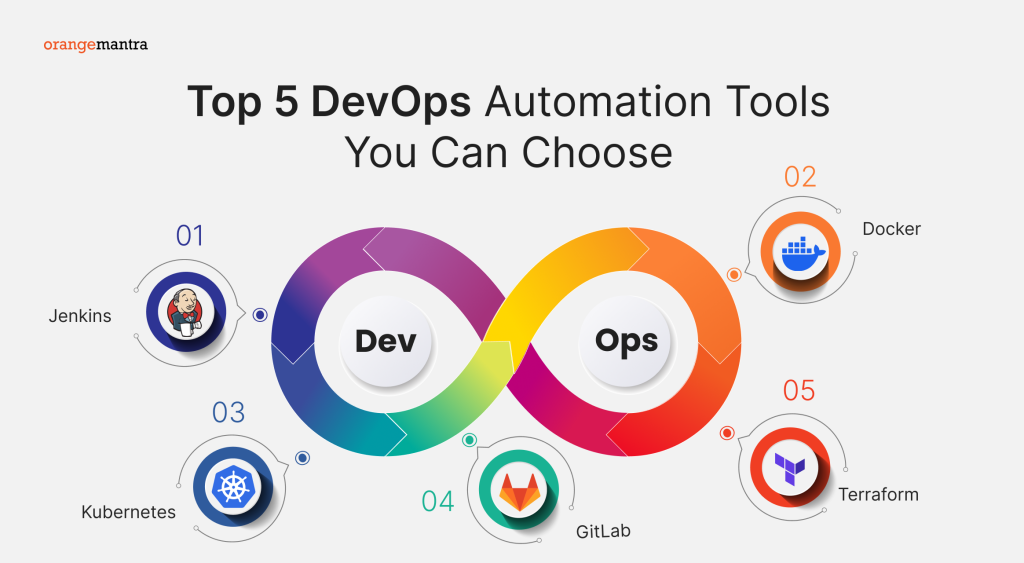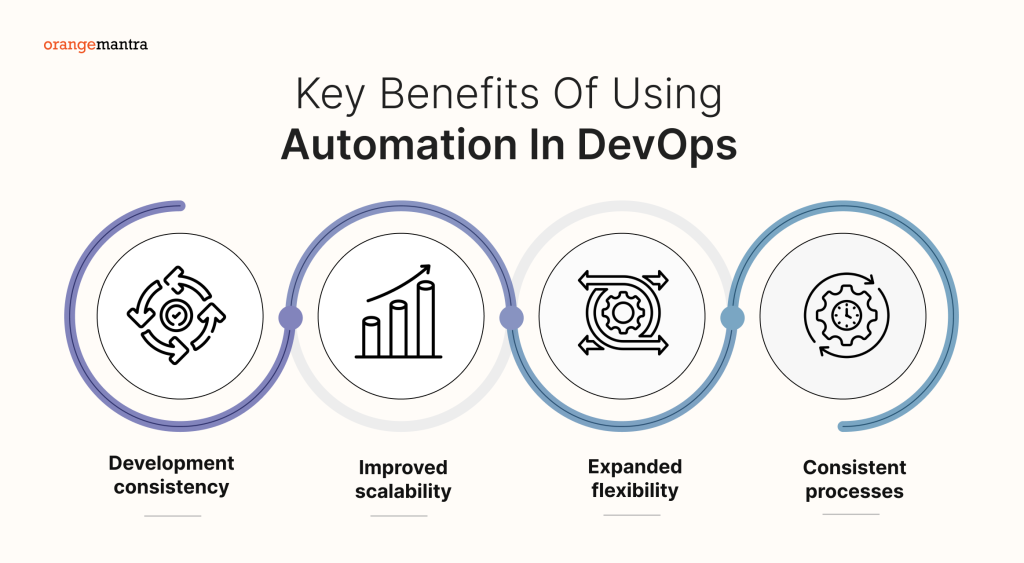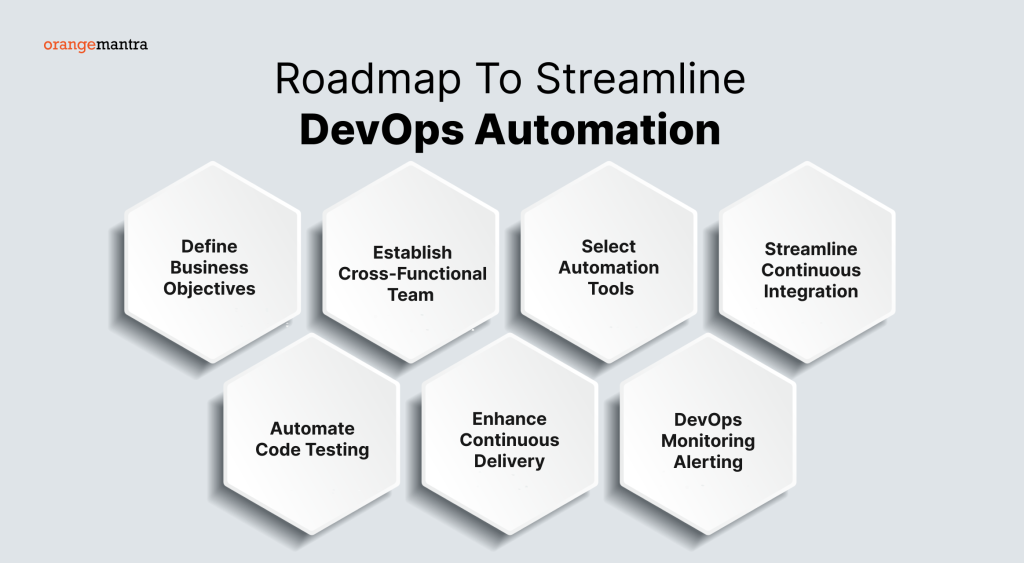Every business demands to fasten their tasks. Because doing every task manually can lead to errors and delays. So, the better option is the automation. DevOps in businesses is the best strategy for collaboration between teams. So, why not choose DevOps automation for tasks and communication? And to satisfy your queries regarding this concept. Here is a quick comprehensive guide for you, let’s know more.
An overview of DevOps automation
DevOps is the amalgamation of development and operations. So, DevOps automation offers a systematic and computer-aided approach. It also controls the manual processes of software development. Such as coding, testing, maintenance, and the deployment of the software. In a DevOps space, you can easily integrate to easily test the code. And you can get software updates quickly to improve.
Also, it promotes the streamlined development and operation team. So, it increases speedy software delivery. And you can get reliability by streamlining the team operations. This can easily speed up the development process with responsive solutions.
Different types of DevOps automation used by businesses
Infrastructure as Code
IaC is a process to automate the infrastructure for the developers. So, it removes the baggage to manage storage or servers for your application. And it enables consistent and repeatable infrastructure to minimize the disruptions. IaC manages code throughout the process even while deploying the code. So, it allows teams to easily control infrastructure to integrate for the software cycle. Integrating the popular tools for IaC:
Terraform
CloudFormation
Ansible
Pulumi
Configuration Management
Second, is a process to automate the configuration tasks and maintaining systems. It reduces the IT, operations, and development-related issues. So, it maintains your computers, servers, and systems. Plus, it ensures consistency with environments and simplifies adjustments.
So, the popular tools used are:
Ansible
Chef
Puppet
Salt Stack
Continuous Integration and Continuous Delivery
The CI and CD DevOps automation helps to automate the deployment. So, it speeds up and automates the deployment of code which speeds up the delivery. The software lifecycle integrates it to reduce errors in the app of the software application lifecycle and reduces integration errors in the app.
The popular tools used for CI/CD are:
Jenkins
Spinnaker
GitLab CI/CD
AWS Code Pipeline
Continuous Monitoring
Lastly, it speeds up the automation of the applications. It is widely used by managers to release and monitor the projects. You can hire DevOps engineers for assistance. So, it helps to identify the bugs and detect them at early stages for the users.
Datadog
ELK stack
Grafana
Prometheus
Top 5 DevOps automation tools you can choose
Jenkins
One of the popular and open-source automation servers used as a pioneer. As it helps in continuous integration and continuous delivery (CI/CD). This widespread plugin offers an incredible ecosystem to customize and integrate. And with vast support in development, testing, and deployment, with automation tools.
Features: Extensive plugins and wide community support for platform independence.
Use Cases: Automating build and test processes for continuous integration pipelines.
Docker
Next is the Docker which revolutionizes the development of applications. You can easily integrate this containerization technology to become the best tool. And with the DevOps automation tools in the industry can automate and offer containers. Ensures it works seamlessly in any environment.
Features: Portability across machines for resource efficiency, and consistency.
Use Cases: Creating isolated environments for the complete software development lifecycle.
Kubernetes
With a container orchestration platform, Kubernetes helps in automating the deployment. And help in scaling and managing the applications. Also, it works hand-in-hand with Docker. Also, it offers a manageable clustering and task scheduling.
Features: Automatic scaling, self-healing, declarative configuration.
Use Cases: Managing complex containerized applications and optimizing resource utilization.
GitLab
Moving to another DevOps automation tool that is vastly used. Git is a cornerstone in source code management for tracking updates and collaborating for codes. And using the DevOps pipeline for distributed architecture to help developers. So, that they work on the codebase.
Features: Branching and merging, the development compatibility with platforms.
Use Cases: Version control, collaboration among team members, for tracking.
Terraform
Lastly, it specializes in IaC as discussed above. Terraform helps teams to easily create and update the infrastructure. So, it can supply the providers with cloud devops solutions platforms for consistent code between environments.
Features: Declarative language with multi-cloud support
Use Cases: Provisioning and managing cloud resources of complex infrastructure.
DevOps is one of the crucial growing strategies to bridge the gap between teams. So, selecting the tool can help you grow your collaboration with incredible tools. You can integrate the capabilities of orchestration, source code management, infrastructure provisioning, and more.
Key benefits of using automation in DevOps
Development consistency
The development process isn’t just developing the application. It consists of the complete process from getting ideas to deploying. You can streamline the development process for smooth operations. So, it transfers the project from a single stage to another stage. It helps the developers and testers to streamline the complete development process.
With DevOps automation, you can reduce manual errors and other loopholes. So, with increased focus, you can get the work done with complete focus. Also, you can get the details of the successful project completion.
Improved scalability
Business growth and solutions may scale up or down as per the needs. So, with the automation of mundane tasks, you can focus on core objectives. Also, this impacts the scaling of the workflow to get a streamlined software lifecycle. Even this means you don’t get an expert IT team to help you. So, that you can easily fasten the routine tasks with the automation process. And this can lead to improved scalability for your business processes.
Expanded flexibility
The dynamic landscape gives birth to the growing market trends. And you must learn about the trends and the needs of your business. But with DevOps automation, you easily change and upgrade as per the user needs. The fast automation helps to measure to help the firms to adapt to the changes. Moreover, with DevOps automation tools you can easily adapt to changes in the dynamics. Even it can plan the resources for the projects and offer an edge in the competition.
Consistent processes
With the automation of these processes, it becomes easy to predict results. And can easily keep the mundane tasks at bay to easily use the algorithms. So, it can keep wye for the processes that are long and boring. And you can easily complete these tasks for the business success. So, that you get the manual processes with consistency and without manual errors.
Also Read – SRE Vs DevOps: What are the Major Differences You Must Know?
What role does Automation play in DevOps?
Accelerates deployment
The DevOps automation is not just for speeding up the delivery process. And with automation, you can streamline the tasks and processes. So, you can easily compile, build, test, and deploy the software in less time. Because the automation reduces the time of the activities. And accelerates reliable software releases and helps the firms to respond easily.
Enhancing efficiency
The automation enables the fastest delivery of software to users. So, automating the mundane tasks can help to focus on the core objectives. With the automated routine tasks, you get the ultimate performance for the users. Such as by configuring environments, provisioning infrastructure, and managing tasks. With DevOps solutions teams can easily optimize productivity to reduce errors.
Enable CI/CD practices
The DevOps automation streamlines the CI/CD pipeline. And with continuous integration consists of automatic code integration. And from the multiple developers can work on it with a shared repository. So, it also fastens the error detection process to improve the functioning. Moreover, CD helps to deploy the software and automate the releases. With deployment pipeline allows firms to easily deliver new features. And this reliably updates the environments for the users.
Improving quality
Businesses expect quality-driven solutions so, the automation can help with that. Automation offers an essential upgrade to your software process. So, you can ensure superior quality and reliability. Also, it helps to automate the testing process to check the bugs at early stages. It also reduces the time to fix your bug.
Facilitates collaboration
Lastly, you get transparent collaboration with other teams with DevOps automation. Because it can help to streamline the development process. To share the toolchain automates seamless integration, and overpower cross-functional. You will get transparency and seamless collaboration among teams. Already it can foster a great collaboration for shared responsibility.
Roadmap to streamline DevOps automation
Define business objectives
You can start by defining the objectives for DevOps automation. And you have to define the areas of the software development before the automation. Because the clear definition can help in an easy automation process. You can start by identifying pain points, and bottlenecks, that come as a loophole in the process. So, consider the opportunities to build processes, test, manage, and monitor the areas.
Establish cross-functional team
With a dedicated cross-functional team you can achieve automation easily. So, the integration of the DevOps automation team can help to lay the foundation of software development. From designing, operations, development, and then deployment of solutions. Also, this team can easily drive the automation to collaborate for tool selection. Plus, these workflows ensure the alignment of teams.
Select automation tools
The automation of DevOps can be easily done with automation tools. So, selecting and evaluating the tools for your organization. It considers technology, requirements, and firm goals. And you must hire DevOps engineers to select the tools for your projects. So, you can easily automate and monitor the stages of software development. And you can easily use the popular tools for automation. Such as Ansible, GitLab, Jenkins, etc.
Streamline continuous integration
Easily implement the automation of continuous tasks. So, you can implement the automated processes to build automated practice. Such as Jenkins, CI/CD, Bamboo, etc. Or you can hire cloud developers for help. And easily you can configure the pipeline to compile the packages. So, you can easily test the code to merge the software. Moreover, it also helps in unit tests, integration tests, and checks for integrity.
Automate code testing
Leverage the automation frameworks to help you automate the type of testing. So, it includes superior testing performance. Such as unit testing, integration testing, functional tests, and more. The usage of DevOps automation helps to detect bugs and errors easily. With ultimate tools, you can get the automated testing completed quickly. And with CI/CD pipelines you can easily validate code for issue correction.
Enhance continuous delivery
With the superior automation deployment tools you can fasten packaging and deployment. Also, the faster delivery of applications can satisfy users and upgrade business success. So, configuring the deployment pipelines to deploy the automated tests and approve changes. So, that you can work in different environments to achieve consistent performance. Moreover, adopt continuous delivery practices to automate the release process.
DevOps monitoring alerting
With the automated monitoring and alerting system tools, you can easily check the applications. And that too easily with relevant metrics. As, it alerts the infrastructure health, application performance, and user experience. So, to configure the alerts the teams help to detect the errors occurring again that disrupt the performance.
Conclusion:
The DevOps strategy is here to mold businesses with ultimate benefits. Such as streamlined operations, collaborations, and more. So, this quick guide will help you get the best automation practices. Or you can consult DevOps implementation services for assistance.
FAQs
Q1. How is automation employed in DevOps?
Ans. DevOps automation is the use of technology to accomplish jobs with less human help in procedures that facilitate feedback loops between operations and development teams, allowing iterative updates to be sent to production applications more quickly.
Q2. Why not automate every step in DevOps?
Ans. In an attempt to automate development processes, people combine too many tools, resulting in over-automation. This amount of DevOps automation might lead to a variety of unwanted results. The key is to establish a balance between over- and under-automation in DevOps.
Q3. What is the future of DevOps automation?
Ans. One of the important themes shaping the future of DevOps is the growing use of artificial intelligence and machine learning. These technologies can automate many of the repetitive processes that software developers and operations teams do, freeing up important time for more complicated duties.
Q4. What are the primary advantages of automated provisioning in DevOps?
Ans. Automated provisioning is a critical DevOps skill that provides computer resources on demand without requiring manual intervention. It lays the groundwork for a flexible, extensible infrastructure with dynamic resource allocation across the company, allowing app delivery at the speed of digital services.
Q5. Will AI replace DevOps?
Ans. No, while AI can automate mundane DevOps chores, it is unlikely to completely replace DevOps engineers, who handle complex, creative problem-solving and strategic planning that AI cannot currently imitate.


























